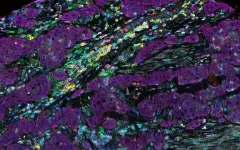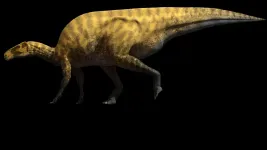New model aims to promote better-adapted bladder cancer treatment in the future
2021-07-07
(Press-News.org) Uppsala University scientists have designed a new mouse model that facilitates study of factors contributing to the progression of human bladder cancer and of immune-system activation when the tumour is growing. Using this model, they have been able to study how proteins change before, while and after a tumour develops in the bladder wall. The study has now been published in the scientific journal PLOS ONE.
"The model was designed both to contain specific oncogenes, as they're called -- mutations that can drive tumour growth -- and to show a high incidence of harmful mutations, which we often see in people who get bladder cancer. These harmful mutations arise because of smoking, for instance, which is the single biggest risk factor for bladder cancer in the West. In that way, our model imitates how this form of cancer develops in humans," explains Sara Mangsbo, principle investigator and senior lecturer at the Department of Pharmaceutical Biosciences at Uppsala University.
The main challenges in creating the mouse model were, first, to produce an organism with an immune system that functions like the human one and, second, to cause the tumour to grow in the right site and for the same reasons as in us. Previous studies and models have often used female mice as mouse models for bladder cancer, which does not fully reflect what the disease is like in humans, where the cancer is three times as common in men as in women. However, women often have a more aggressive cancer at the time of diagnosis. In the new model, both sexes have been investigated and it can therefore be used to study how tumours develop in females and males respectively, and how both respond to various treatments.
The scientists have now used the model to take a closer look, in blood and urine, at the proteomic profile (secreted substances from the tumour/immune cell area) when the tumour arise, grow and spread. The investigations included examining more than 90 proteins to find out how these change in the course of tumour development and after the disease has infiltrated the muscle layer), called muscle-invasive bladder cancer.
How the gene expression in the tumour changed from when it was confined to only one site to when it had infiltrated the tumour was studied through "single-cell sequencing". Thus, the researchers were able to get an idea of which cells were appearing and which disappearing, how cancer cells and surrounding tissue were interacting and which types of immune cell were being activated.
The scientists noted a distinct gender difference both in the type of bladder cancer that developed in the early stage of the disease, but also that the sexes responded differently to immunotherapy, a form of treatment that activates the immune system to fight tumours.
"In the next phase of the project, the model can give us a better understanding of the types of immune cell that infiltrate the tumours. And we hope that, in the future, it will help to improve our knowledge of how to design treatment strategies specifically adapted for men and women. For this to become a reality, studies must also be linked to analyses of clinical material from biobanks," Mangsbo says.
The work of developing the tumour model and studying it at the level of pathology, proteomics and single cells is a collaboration involving the Sara Mangsbo lab at the Department of Pharmaceutical Biosciences; Anca Dragomir, Sven Nelander and Milena Doroszko at Immunology, Genetics and Pathology; and, in the lead, Ulrika Segersten and Per-Uno Malmström at Surgical Sciences.
INFORMATION:
The research is funded by the Swedish Cancer Society, the Swedish Society for Medical Research and the European Social Fund (the "IOCB MSCA Mobility" project).
Iliana K. Kerzeli et al. (2021), Single-cell RNAseq and longitudinal proteomic analysis of a novel semi-spontaneous urothelial cancer model reveals tumor cell heterogeneity and pretumoral urine protein alterations, PLOS ONE.
https://journals.plos.org/plosone/article?id=10.1371/journal.pone.0253178
Facts about bladder cancer
Cancer of the bladder is the fourth most common form of cancer in men in western countries. In Europe more than 120,000 people are diagnosed annually with bladder cancer -- roughly three times as many men as women. About three out of four survive their cancer, but the mortality rate is slightly higher among women than men, which can be explained by the fact that women more frequently get a more aggressive form of the disease. Onset before the age of 50 is unusual, and most people who fall ill are over 65 years old.
[Attachments] See images for this press release:

ELSE PRESS RELEASES FROM THIS DATE:
2021-07-07
Sudanese Islamic burial sites are distributed according to large-scale environmental factors and small-scale social factors, creating a galaxy-like distribution pattern, according to a study published July 7, 2021 in the open-access journal PLOS ONE by Stefano Costanzo of the University of Naples "L'Orientale" in Italy and colleagues.
The Kassala region of eastern Sudan is home to a vast array of funerary monuments, from the Islamic tombs of modern Beja people to ancient burial mounds thousands of years old. Archaeologists don't expect these monuments are randomly placed; their ...
2021-07-07
GPS data from cell phones may provide insight into how city inhabitants are using their urban greenspaces, in a study published July 7, 2021 in the open-access journal PLOS ONE by Meghann Mears and Paul Brindley from the University of Sheffield, UK, and colleagues.
Urban greenspaces confer a range of health and well-being benefits on city inhabitants and provide connection to nature. In this study, Mears and colleagues use cellphone GPS data to assess how frequently residents of the city of Sheffield in the UK engage with their local urban greenspaces, and whether this engagement was different across demographic groups.
The authors used the "Shmapped" app, developed as part of the Improving Well-being through Urban Nature project, to track how frequently 240 users based in Sheffield ...
2021-07-07
New iguanodon-like dinosaur identified from jawbone fossil from Spain was likely a 6-8m long herbivore, closely related to species found in modern-day China and Niger.
INFORMATION:
Article Title: A new Styracosternan hadrosauroid (Dinosauria: Ornithischia) from the Early Cretaceous of Portell, Spain
Funding: The authors received no specific funding for this work.
Competing Interests: The authors have declared that no competing interests exist.
Article URL: https://journals.plos.org/plosone/article?id=10.1371/journal.pone.0253599
...
2021-07-07
Brain microstructure may help explain the benefits of physical activity on cognition in older adults, according to MRI scans of 318 brains post-mortem.
INFORMATION:
Article Title: Physical activity, brain tissue microstructure, and cognition in older adults
Funding: This work was supported in part by the National Institute on Aging (https://www.nia.nih.gov) grants K25 AG61254 (RJD), K01 AG64044 (VNP), K01 AG50823 (BDJ), R01 AG17917 (DAB), R01 AG47976 (ASB), R01 AG56352 (ASB), R01 AG64233 (JAS, KA), and P30 AG10161 (DAB), the National Institute of Neurological Disorders and Stroke (https://www.ninds.nih.gov) grant UH3 NS100599 ...
2021-07-07
HOUSTON - (July 7, 2021) - A thin shell of soft polymer can help keep knotty ceramic structures from shattering, according to materials scientists at Rice University.
Ceramics made with 3D printers crack under stress like any plate or bowl. But covered in a soft polymer cured under ultraviolet light, the same materials stand a far better chance of keeping their structural integrity, much like a car windshield's treated glass is less likely to shatter.
The research at Rice's Brown School of Engineering, which appears in Science Advances, demonstrates the concept on schwarzites, complex lattices that for decades existed only as theory but can now be made with 3D printers. With added polymers, they come to resemble structures ...
2021-07-07
Microscopists have long sought to find a way to produce high-quality, deep-tissue imaging of living subjects in a timely fashion. Until now, they had to choose between image quality or speed when it comes to looking into the inner workings of complex biological systems.
Such a development would have a powerful impact on researchers in biology and in neuroscience, experts say. Now Dushan N. Wadduwage, a John Harvard Distinguished Science Fellow in Imaging at the FAS Center of Advanced Imaging, along with a team from MIT, detailed a new technique that would make that possible in a report in Science Advances.
In the paper, the team presents a new process that uses computational imaging to get high resolution images at a rate 100 to 1,000 times faster than other state-of-the-art ...
2021-07-07
Increased acidity in the atmosphere is disrupting the ecological balance of the oceans, according to new research led by the University of East Anglia (UEA).
The first study to look at acidity's impact on nutrient transport to the ocean demonstrates that the way nutrients are delivered affects the productivity of the ocean and its ability to absorb CO2 from the atmosphere.
The research, 'Changing atmospheric acidity as a modulator of nutrient deposition and ocean biogeochemistry', is published today in Science Advances. The analysis was carried out by an international team of experts, sponsored by the United Nations Group of Experts on the Scientific Aspects of Marine Environmental Protection (GESAMP).
Prof Alex Baker, professor of marine and atmospheric chemistry ...
2021-07-07
To create high-resolution, 3D images of tissues such as the brain, researchers often use two-photon microscopy, which involves aiming a high-intensity laser at the specimen to induce fluorescence excitation. However, scanning deep within the brain can be difficult because light scatters off of tissues as it goes deeper, making images blurry.
Two-photon imaging is also time-consuming, as it usually requires scanning individual pixels one at a time. A team of MIT and Harvard University researchers has now developed a modified version of two-photon imaging that can image deeper within tissue and perform the imaging much more quickly than what was previously possible.
This kind of imaging could allow scientists to more rapidly obtain ...
2021-07-07
Metastatic tumors originating from notoriously aggressive triple-negative breast cancer that emerge in the lungs contain a more diverse array of cancer cells than those that arise in the liver, according to a new study in mice and organs from deceased cancer patients. The study also identified a set of genes that distinguish lung and liver metastases; together, the findings may inform future research on how targeted therapies impact tumors across various microenvironments. While scientists have known that the presence of distinct tumor cell populations within the same tumor drives breast cancer progression, it has not been fully understood why this dangerous cellular diversity develops within some tumors and not others. To investigate ...
2021-07-07
From above, the Antarctic Ice Sheet might look like a calm, perpetual ice blanket that has covered Antarctica for millions of years. But the ice sheet can be thousands of meters deep at its thickest, and it hides hundreds of meltwater lakes where its base meets the continent's bedrock. Deep below the surface, some of these lakes fill and drain continuously through a system of waterways that eventually drain into the ocean.
Now, with the most advanced Earth-observing laser instrument NASA has ever flown in space, scientists have improved their maps of these hidden lake systems under the West Antarctic ice sheet--and ...
LAST 30 PRESS RELEASES:
[Press-News.org] New model aims to promote better-adapted bladder cancer treatment in the future





